Abstract
Background: Ten new sesquiterpenes, including eight eremophilane-type sesquiterpenes (1–8) and two compounds (9–10) with a cyclopentane ring, representing an undescribed subtype of sesquiterpene, along with a new abietane-type diterpenoid (11), were isolated and identified from a deep-sea-derived fungus: Eutypella sp. Methods: Their structures were elucidated on the basis of various spectroscopic analyses, mainly including nuclear magnetic resonance (NMR) and high-resolution electrospray ionization mass spectrometry (HRESIMS) data, 13C NMR calculations with DP4+ probability analyses, electronic circular dichroism (ECD) calculations, and single-crystal X-ray diffraction experiments. Results: Furthermore, compound 11 exhibited potent immunosuppressive activity with IC50 values of 8.99 ± 1.08 μM in a lipopolysaccharide (LPS) model and 5.39 ± 0.20 μM in a concanavalin A (ConA) model.
1. Introduction
The dynamic environmental conditions of the ocean, characterized by significant fluctuations in pressure, salinity, temperature, pH, nutrient availability, and light intensity, exert selective pressures that drive marine microorganisms to evolve unique metabolic pathways for enhanced adaptation. This evolutionary process endows marine-derived secondary metabolites with remarkable bioactivities such as antitumor, antibacterial, and antiviral properties, while their distinct chemical scaffolds provide invaluable molecular resources for innovative drug discovery [1]. Marine fungus-derived bioactive compounds are potently applied for treatments of diseases [2,3], such as the antibiotics cephalosporin C, griseofulvin, and fusidic acid, used for the treatment of various pathogenic infections [4]. Research on fungi of the genus Eutypella over the past two decades has yielded diverse compounds, including terpenoids, cytochalasins, steroids, lactones, and diketopiperazines, which demonstrate notable cytotoxic, antibacterial, and anti-inflammatory activities [5,6,7,8,9,10]. The researchers isolated γ-lactones, sesquiterpenoids, and diterpenoids with moderate cytotoxic activity from the fermentation broth of Eutypella sp. BCC-13199, an endophyte of Zingiber species native to Thailand [6]. Epigenetic manipulation activated the sesquiterpene pathway in the fungus Eutypella sp., and twenty-six new eremophilane-type sesquiterpenoids were isolated, and two of their compounds exerted significant inhibition on NO production [11]. Jiao Binghua et al. isolated seven pimarane-type diterpenoid derivatives from Eutypella sp. D-1, a fungal strain obtained from high-latitude Arctic soils [8]. These compounds exhibited cytotoxic activity against human cancer cell lines and inhibited lipopolysaccharide (LPS)-induced NO production in lymphocytes. Terpenoids, with their unique chemical structures and broad spectrum of biological activities, demonstrate significant potential in the field of immunosuppression. Representative terpenoid immunosuppressive agents include triptolide [12], oridonin [13], and pseudopterosins [14]. With the aim of discovering bioactive natural products from deep sea organisms, we examined the metabolites of an unidentified fungus species, Eutypella sp. MCCC 3A00281, that was obtained from the deep sea sediment at a depth of 5610 m in the South Atlantic Ocean. Chromatographic separation of the EtOAc extract from the fermented fungus yielded a series of terpenes, including ten new sesquiterpenes (1–10) and one novel abietane-type diterpene (11) (Figure 1). Herein, we report their isolation and structural elucidation, and an evaluation of immunosuppressive activities.
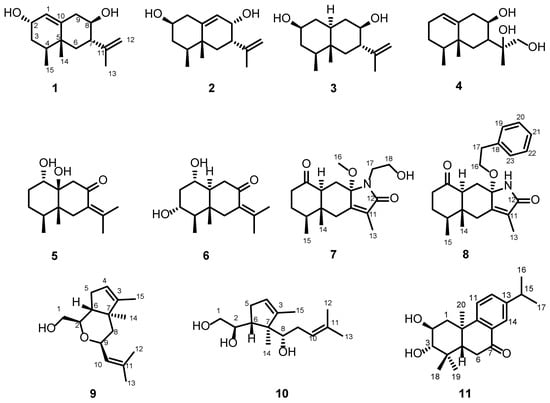
Figure 1.
Structures of compounds 1–11.
2. Results and Discussion
2.1. Structural Elucidation
Compound 1 was isolated as a colorless oil. The molecular formula was established as C15H24O2 on the basis of an HREIMS peak at m/z 259.1663 [M + Na+] (calcd for C15H24O2Na+, 259.1674), consistent with 4 degrees of unsaturation. The 1H NMR data (Table 1) and heteronuclear single quantum coherence (HSQC) spectrum of compound 1 (Figure S4) reveal the following signals: three methyls (δH 1.65, 0.84, and 0.80), two terminal olefinic protons (δH 4.72), three methylenes (δH 1.35/1.49, 1.06/1.61, 2.21), two oxygenated methines (δH 3.84, 3.26), two methines (δH 1.64, 2.18), one olefinic methine (δH 5.38), and two exchangeable proton signals (δH 4.43, 4.45). The 13C NMR data (Table 2) and DEPT-135 spectrum (Figure S3) confirm the presence of 15 carbons, including the following: three methyls (δC 15.5, 16.5, 19.5), three methylenes (δC 36.2, 41.6, 42.7), one olefinic methylene (δC 111.2), two oxygenated methines (δC 62.3, 71.2), one olefinic methine (δC 124.2), two methines (δC 33.9, 48.5), one quaternary carbon (δC 37.2), and two olefinic quaternary carbons (δC 143.9, 147.4). The 13C NMR data of compound 1 closely align with those of the known eremophilane-type sesquiterpene 7βH-eremophil-1(10),11(12)-dien-2β,8β-diol [15]. However, distinct differences are observed in the chemical shifts and coupling constants of H-1, H-2, and H2-3 and their corresponding carbons (C-1, C-2, C-3), suggesting potential structural modifications in these regions. The planar structure of Compound 1 was determined to be identical to that of the known compound based on heteronuclear multiple bond correlation (HMBC) and 1H-1H correlation spectroscopy (1H-1H COSY) correlations (Figure 2).

Table 1.
1H NMR data (δ in ppm, J in Hz) for compounds 1–5.

Table 2.
13C NMR data (δ in ppm) for compounds 1–5.
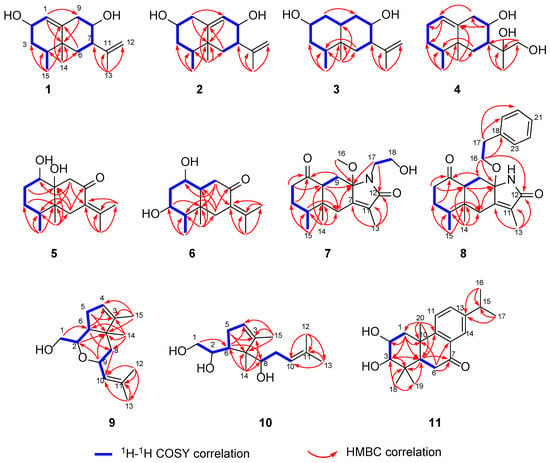
Figure 2.
The key 1H−1H COSY and HMBCs of compounds 1–11.
The relative configurations were established on the basis of nuclear Overhauser effect spectroscopy (NOESY) cross peaks. As a general tendency, biosynthesis results in eremophilane structures with CH3-14 in β-orientation; consequently, this position was assigned accordingly. The key NOESY cross-peaks (Figure 3) between H-3ax (δH 1.49)/CH3-15 (δH 0.80)/CH3-14 (δH 0.84), CH3-14/H-6eq (δH 1.61)/H-7 (δH 2.18), OH-2 (δH 4.43)/H-4 (δH 1.64), H-4/H-6ax (δH 1.06), and H-6ax/H-8 (δH 3.26) collectively support the β-orientations of CH3-14, CH3-15, and H-7, while H-2, H-4, and H-8 adopt α-orientations. Therefore, the relative configuration of compound 1 was deduced as 2S*,4S*,5R*,7S*,8R*. Finally, the absolute configuration of compound 1 was assigned as 2S,4S,5R,7S,8R by comparison of its experimental and computed ECD curves (Figure 4).
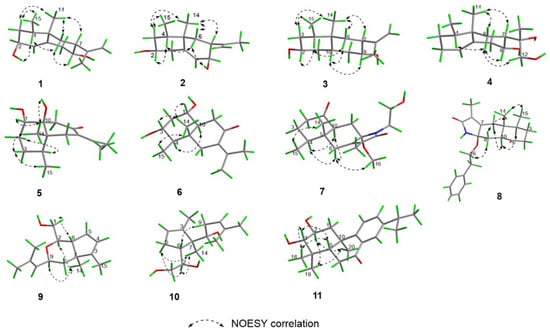
Figure 3.
The key NOESY correlations of compounds 1–11.
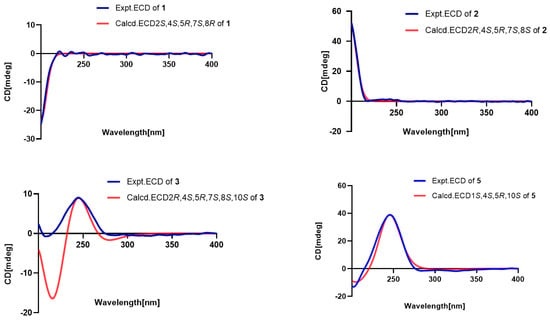
Figure 4.
Experimental and calculated ECD spectra of compounds 1–3, 5.
Compound 2 was isolated as a colorless oil. The molecular formula was established as C15H24O2 on the basis of a HREIMS peak at m/z 259.1668 [M + Na+] (calcd for C15H24O2Na+, 259.1674). The HMBC and 1H-1H COSY correlations revealed that the double bond position in compound 2 was altered compared to compound 1, shifting from C-1–C-10 to C-9–C-10 (Figure 2). The key NOESY cross-peaks of CH3-15 (δH 0.80)/CH3-14 (δH 0.84) and H-3ax (δH 1.49), CH3-14 and H-7 (δH 2.18), and OH-2 (δH 4.43)/H-4 (δH 1.64)/H-6ax (δH 1.06)/H-8 (δH 3.26) suggested that H-7, CH3-14, and CH3-15 were on the same side with β-orientations, while H-2, H-4, and H-8 was on the opposite side (α-orientation). The absolute configuration of compound 2 (2R,4S,5R,7S,8S) was determined by comparative analysis of ECD calculations and experimental data (Figure 4).
Compound 3 was determined to have the molecular formula C15H26O2, as deduced from the HRESIMS data (m/z 261.1826 [M + Na+], calcd for C15H26O2Na+, 261.1830). The 1H NMR data (Table 1) displayed three methyls (δH 1.63, 0.72, and 0.68), five methylenes (δH 4.67, 1.52/1.13, 1.44/0.91, 1.45/1.24, and 1.40/1.04), five methines (δH 3.39, 3.29, 2.05, 1.10, and 1.09), and two hydroxyls (δH 4.43 and 4.19). The 13C NMR spectrum (Table 2) showed 15 carbon signals attributed to three methyls (δC 19.6, 15.3, and 11.2), five methylenes (δC 110.9, 42.9, 40.1, 40.0, and 37.8), five methines (δC 70.9, 68.7, 48.6, 41.8, and 40.6), and two non-protonated carbons (δC 148.0 and 35.4). The 1D-NMR data of 3 combined with the sequential 1H-1H COSY correlations of Me-15/H-4/CH2-3/H-2/CH2-1/H-10/CH2-9/H-8/H-7/CH2-6, as well as the key HMBC from Me-15 to C-3/C-4/C-5, Me-14 to C-4/C-5/C-6/C-10, C-6 to C-4, and Me-13 to C-12/C-7/C-11 suggested an eremophilane sesquiterpene with a 6/6-fused ring system skeleton.
Key NOESY correlations (Figure 3) revealed spatial proximities: CH3-14 (δH 0.68) to H-7 (δH 2.05) and H-3ax (δH 1.13), and Me-15 (δH 0.72) to H-3ax, supporting β-orientations for CH3-14, CH3-15, and H-7; H-2 (δH 3.39)/H-4 (δH 1.09)/H-10 (δH 1.10)/H-8 (δH 3.29)/H-6ax (δH 0.91), indicating α-orientations for these protons. The absolute configuration of compound 3 (2R,4S,5R,7S,8S,10S) was determined by comparative analysis of ECD calculations and experimental data.
Compound 4 gave a molecular formula of C15H26O3, as evidenced via its HRESIMS data. The 1H and 13C NMR signals (Table 1 and Table 2), along with the 1H−1H COSY and HMBC spectrum, showed that the planar structure of compound 4 is similar to valenc-1(10)-ene-8,11-diol [16]. Unlike known compounds, the hydroxymethyl group was assigned to C-12 based on the HMBC long-range correlations between the proton signal at δH 3.75 (H-12) and C-7, C-11, and C-13. The NOESY correlations (Figure 3) from CH3-14 (δH 0.95) to H-6β (δH 1.83)/H-7 (δH 1.90), and cross-peaks of H-4 (δH 1.33)/H-6ax (δH 0.78)/CH3-12 (δH 3.75) determined that CH3-14, CH3-15, and H-7 were on the same side with β-orientations. Considering the biosynthetic pathway and single-crystal X-ray diffraction experiment, the absolute configuration of compound 4 was confirmed as 4S,5R,7R,8R,11S by the single-crystal X-ray diffraction analysis using Cu Kα radiation (Figure 5) [Flack parameter = 0.03(12), CCDC 2431789].
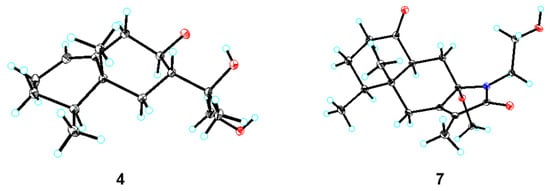
Figure 5.
X-ray crystal structures of compounds 4 and 7. Black represents C atoms, blue represents H atoms, red represents O atoms.
Compound 5 was isolated as a colorless oil and provided a molecular formula of C15H24O3, according to its HRESIMS data (m/z 275.1631 [M + Na+]), which suggested four degrees of unsaturation. The 1H NMR data (Table 1) displayed four methyls (δH 1.81, 1.75, 0.83, and 0.77), four methylenes (δH 2.66/2.31, 2.44/2.37, 1.63/1.33, and 1.43/1.30), two methines (δH 3.53 and 1.69), and two hydroxyls (δH 4.45 and 4.35). The 13C NMR spectrum (Table 2) of compound 5 showed 15 carbon signals attributed to four methyls (δC 22.2, 21.2, 16.0, and 14.2), four methylenes (δC 45.0, 35.9, 30.9, and 28.4), two methines (δC 71.3 and 32.4), and five non-protonated carbons (δC 203.4, 137.7, 131.1, 78.3, and 42.2). The planar structure of compound 5 was inferred to be identical to eutyperemophilane R by 1H-1H COSY and HMBC data (Figure 2) [11]. The difference between compound 5 and eutyperemophilane R was that C-10 was hydroxylated in compound 5.
The NOE correlations of Me-14 (δH 0.83) with OH-10 (δH 4.45)/ H-1 (δH 3.53), H-3ax (δH 1.30) with Me-14 (δH 0.83)/ Me-15 (δH 0.77), and H-4 (δH 1.69) with H-2ax (δH 1.32) revealed relative configuration. The absolute configuration of compound 5 (1S,4S,5R,10S) was determined by comparative analysis of ECD calculations and experimental data (Figure 4).
Compound 6 gave a molecular formula of C15H24O3, as evidenced via its HRESIMS data. Although compound 6 shares the same molecular formula as compound 5, its planar structure was deduced to have a 1,3-dihydroxy substitution based on 1H-1H COSY and HMBCs (Figure 2). Analysis of the NOESY correlations (Figure 3), the spatial proximities between CH3-14 and H-1, H-3, and CH3-15 indicate β-configurations for H-1, H-3, and CH3-15. The correlation between H-10 and H-4 suggests an α-configuration for H-10. The relative configuration of compound 6 was determined as 1S*,3R*,4R*,5R*,10S*, while absolute configuration was confirmed by comparative analysis of ECD calculations and experimental data.
Compound 7 was isolated as a colorless needle crystal. The molecular formula was established as C18H27NO4 on the basis of a HREIMS peak at m/z 344.1835 [M + Na+] (calcd for C18H27NO4Na+, 344.1838). The 1H and 13C NMR data (Table 3 and Table 4) of compound 7 were very similar to those of the known compound eremophilane lactam, which indicated that both compounds shared the same core skeleton [11]. The difference between compound 7 and eremophilane lactam was the substitution of the N-H hydrogen with a hydroxyethyl group, as supported by the key HMBCs from H2-17 to C-8 and C-12. Considering the NOE correlations and single-crystal X-ray diffraction experiment (Figure 5), the absolute configuration of compound 7 was confirmed as 4S,5R, 8S,10S by the single-crystal X-ray diffraction analysis using Cu Kα radiation [Flack parameter = 0.01(6), CCDC 2431799].

Table 3.
1H NMR data (δ in ppm, J in Hz) for compounds 6–10.

Table 4.
13C NMR data (δ in ppm) for compounds 6–10.
Compound 8 possessed a molecular formula of C23H29NO3, as determined by the HRESIMS and NMR data. Comprehensive analysis of the NMR data of compound 7 and compound 8 suggested that both compounds were structural analogs; the difference lies in the substitution of a methyl group in compound 7 with a phenethyl group in compound 8, accompanied by N-reduction. This structural modification was corroborated by HMBCs between H2-16 and C-18, as well as between H2-17 and C-18, C-19, and C-20 (Figure 2).
By analysis of the NOESY data, Me-14 (δH 0.47) showed strong NOESY correlations to Me-15 (δH 1.00) and H-9ax (δH 1.35), indicating that Me-15, Me-14, and H-9ax were on the same face with β-orientations, while cross-peaks of H-4 (δH 2.02)/H-10 (δH 2.73) suggested that H-10 was on the opposite side (α-orientation). The correlation of H-16 (δH 3.45)/H-9eq (δH 2.26) suggested that hyphenated oxygen groups were α-oriented. The absolute configuration was determined by a comparative analysis of ECD calculations and experimental data.
Compound 9 was isolated as a colorless oil. The molecular formula was established as C15H24O2 on the basis of a HREIMS peak at m/z 259.1668 [M + Na+] (calcd for C15H24O2Na+, 259.1674), bearing four degrees of unsaturation. The 13C NMR spectrum exhibited 15 carbon resonances, including four olefinic carbons for two double bonds, a sp3 quaternary carbon, three methylenes, three methines, and four methyl groups (Table 3 and Table 4). The COSY correlations of H-5 (δH 1.92, 2.04) with H-4 (δH 5.28) and H-6 (δH 1.71), together with the HMBCs from CH3-15 (δH 1.65) to C-3 (δC 150.9), C-4 (δC 122.5), and C-7 (δC 45.6), and from CH3-14 (δH 0.95) to C-3, C-6 (δC 50.7), and C-7, established a dimethylcyclopentene unit. The COSY correlations from H-6 to H-2 (δH 3.81) and CH2-1 (δH 3.68), and from H-9 (δH 4.54) to CH2-8 (δH 1.32, 1.54) and H-10 (δH 5.19), in association with the HMBC from CH2-1 to C-2 (δC 75.8) and C-6, and from H-9 to C-7 and C-2, fused a pyran ring to the cyclopentene nucleus. In addition, a 2-methylpropenyl side chain was deduced based on the HMBCs of CH3-12 (δH 1.73)/CH3-13 (δH 1.69) with C-10 (δC 126.6) and C-11 (δC 135.3). This side chain was connected to C-9 via the HMBCs between CH2-8 and C-10 (Figure 2).
The NOE correlations from CH3-14 and H-2/H-9, as well as between H-1 and H-6, indicate that H-2, CH3-14, and H-9 are positioned on the opposite face relative to H-6 (Figure 3). The experimental ECD data of compound 9 were similar to the calculated data for (2R,6R,7S,9S)-9 (Figure 6), determining the absolute configuration.
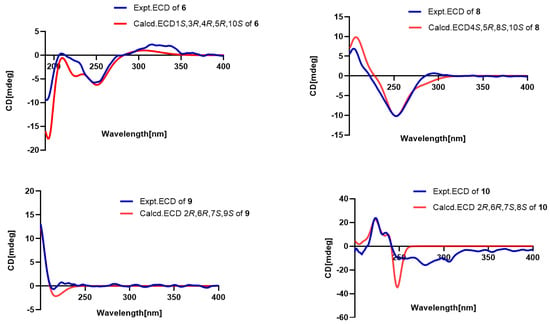
Figure 6.
Experimental and calculated ECD spectra of compounds 6, 8–10.
Comparative analysis of 1D NMR data combined with COSY and HMBCs revealed that compound 10 shares identical partial structures (cyclopentene unit and side chain) with compound 9. The key structural divergence lies in the formation of a pyran ring in compound 9 via dehydration–condensation between OH-9 and OH-2, whereas in compound 10, C-8 is oxidized to a hydroxyl group without oxygen ring formation.
In the NOESY spectrum, H-6 showed correlations with H-9, and CH3-14 exhibited mutual correlations with H-2 and H-5ax. A weak correlation between H-6 and H-5ax, contrasted with a strong correlation between H-6 and H-5eq, indicated that CH3-14, H-5ax, and H-2 are positioned on the opposite face of the ring relative to H-6. The relative configuration was deduced as 2R*,6R*,7S*. Based on Snatzke’s method [17], the treatment of 10 with Mo2(OAc)4 derived an Mo2(OAc)4 complex, whose ECD data showed a positive cotton effect at 311 nm and 400 nm in DMSO (Figure 7), reflecting the 2R configuration. To identify the final structure for compound 10, the theoretical 13C NMR calculation with DP4+ probability analyses were employed. The 13C NMR chemical shifts in two possible isomers, 10A (2R,6R,7S,8R*) and 10B (2R,6R,7S,8S*), were calculated at the B3LYP-D3(BJ)/6-31G* level, and the calculated results for 10B (R2 = 0.9973) showed a better match to the experimental data than 10A (R2 = 0.995). Furthermore, according to the DP4+ probability analyses, 10B was assigned with a 100% probability (Figure 8). The above messages demonstrated 10B to be the right relative structure for compound 10. The absolute configuration of compound 10 was finally determined as 2R,6R,7S,8S by comparison of the experimental and computed ECD curves (Figure 6).
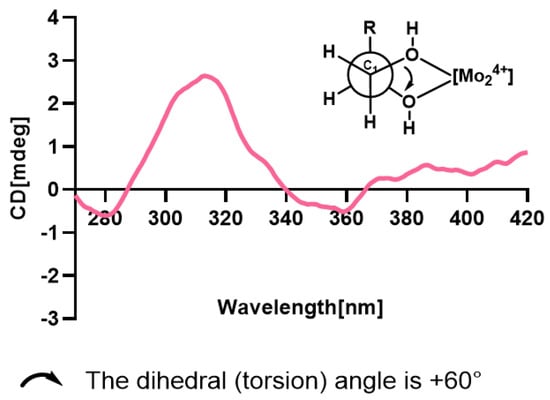
Figure 7.
ECD spectra of the Mo2(AcO)4 complex of compound 10.
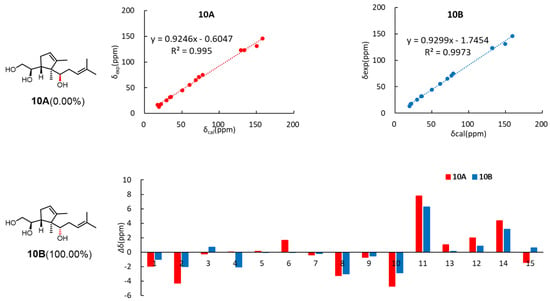
Figure 8.
13 C NMR calculation results of two possible isomers of compound 10.
The molecular formula of compound 11 was established as C20H28O3 by the HRESIMS data. The 1H and 13C NMR data of compound 11 were comparable to the known compound hydroxyldecandrin G [18], but exhibited an additional proton signal δH 2.84 and distinct chemical shift differences in the side chain (C-11–C-17): C-11 (ΔδC +0.6), C-12 (ΔδC +1.7), C-13 (ΔδC +1.7), C-14 (ΔδC +1.1), C-15 (ΔδC −37.8), and C-16/17 (ΔδC −7.5) (Table 5). These discrepancies could only be rationalized by proposing the reduction of the OH-15 group. This hypothesis was further corroborated by 1H–1H COSY and HMBC analyses (Figure 2), which confirmed the planar structure. The NOESY correlations from CH3-18 to H-5 and H-3 and from H-2 to CH3-19 and CH3-20, along with the coupling constant between H-2 and H-3 (J = 9.7 Hz), revealed the relative configuration of compound 11. The absolute configuration of compound 11 (2S,3S,5S,10R) was determined by comparing its 1D NMR data with the known compound hydroxyldecandrin G, as well as by analyzing the agreement between the calculated and experimentally measured ECD spectra (Figure 9).

Table 5.
1H and 13C NMR data (δ in ppm, J in Hz) for compound 11 (CD3OD).
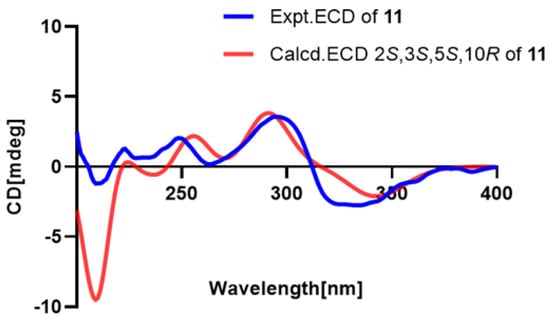
Figure 9.
Experimental and calculated ECD spectra of compound 11.
2.2. Immunosuppressive Activity
In the concanavalin A (ConA)-induced lymphocyte proliferation assay, compounds 1 and 9 exhibited moderate inhibitory activity with half-maximal inhibitory concentration (IC50) values of 13.55 ± 1.40 μM and 29.25 ± 1.56 μM, respectively. Notably, compound 11 demonstrated more potent suppression against both lipopolysaccharide (LPS)- and ConA-induced lymphocyte proliferation, showing IC50 values of 8.99 ± 1.08 μM (LPS model) and 5.39 ± 0.20 μM (ConA model). Compound 11 exhibited potent activity, presumably attributed to its diterpenoid nature, while the enhanced activity of compound 1 among sesquiterpenoid analogs may be due to the presence of a double bond between C-1 and C-10.
2.3. Spectroscopic Data of Compounds
2.3.1. Compound 1
2.3.2. Compound 2
Colorless oil; +238 (c 0.1, MeOH), UV (MeCN) λmax (log ε) = 195 (4.02), 226 (2.27) nm; ECD (MeCN) λmax (Δε) = 198 (+15.25), 218 (+0.01) nm; IR (KBr) νmax 3360, 2964, 2931, 2856, 1685, 1461, 1443, 1034, 1019 and 888cm−1 cm−1; for 1H and 13C NMR data, see Table 1 and Table 2; HRESIMS m/z 259.1668 [M + Na+] (calcd. for C15H24O2Na+, 259.1674).
2.3.3. Compound 3
Colorless oil; −61 (c 0.1, MeOH), UV (MeCN) λmax (log ε) = 200 (4.20), 220 (2.93) nm; ECD (MeCN) λmax (Δε) = 209 (−0.13), 245 (+1.64), 258 (−0.08) nm; IR (KBr) νmax 3325, 2969, 2926, 2857, 1648, 1466, 1444, 1032 and 883 cm−1; for 1H and 13C NMR data, see Table 1 and Table 2; HRESIMS m/z 261.1826 [M + Na+] (calcd. for C15H26O2Na+, 261.1830).
2.3.4. Compound 4
Colorless needle crystals; −391 (c 0.1, MeOH), UV (MeCN) λmax (log ε) = 192 (4.48), 373 (1.00) nm; ECD (MeCN) λmax (Δε) = 204 (−0.70) nm; IR (KBr) νmax 3379, 2963, 2923, 2855, 1663, 1459, 1381 and 1039 cm−1; for 1H and 13C NMR data, see Table 1 and Table 2; HRESIMS m/z 277.1771 [M + Na+] (calcd. for C15H26O3Na+, 277.1780).
2.3.5. Compound 5
2.3.6. Compound 6
White amorphous powders; +126 (c 0.1, MeOH), UV (MeCN) λmax (log ε) = 191 (3.89), 215 (3.36), 249 (3.84), 393 (1.46) nm; ECD (MeCN) λmax (Δε) = 192 (−2.48), 209 (+0.15), 226 (−0.37), 228 (−0.31), 245 (−1.52) nm; IR (KBr) νmax 3393, 2968, 2923, 2854, 1671, 1453 and 1043 cm−1; for 1H and 13C NMR data, see Table 3 and Table 4; HRESIMS m/z 275.1626 [M + Na+] (calcd. for C15H24O3Na+, 275.1623).
2.3.7. Compound 7
Colorless needle crystals; −286 (c 0.1, MeOH), UV (MeCN) λmax (log ε) = 214 (3.85), 375 (−0.54) nm; ECD (MeCN) λmax (Δε) = 192 (+1.20), 203 (+2.29), 223 (−2.01), 237 (−0.77), 253 (−1.26) nm; IR (KBr) νmax 3429, 2966, 2921, 2850, 1717, 1657 and 1407 cm−1; 1H and 13C NMR data, see Table 3 and Table 4; for HRESIMS m/z 344.1835 [M + Na+] (calcd. for C18H27NO4Na+, 344.1838).
2.3.8. Compound 8
White amorphous powders; −341 (c 0.1, MeOH), UV (MeCN) λmax (log ε) = 210 (4.21), 371 (−0.18) nm; ECD (MeCN) λmax (Δε) = 205 (+5.16), 252 (−7.58) nm; IR (KBr) νmax 3337, 2962, 2929, 1709, 1692, 1670, 1454, 1434, 1416, 701 cm−1; for 1H and 13C NMR data, see Table 3 and Table 4; HRESIMS m/z 390.2045 [M + Na+] (calcd. for C23H29NO3Na+, 390.2045).
2.3.9. Compound 9
2.3.10. Compound 10
White amorphous powders; −10 (c 0.1, MeOH), UV (MeCN) λmax (log ε) = 200 (3.96) nm; ECD (MeCN) λmax (Δε) = 193 (−16), 200 (−0.35), 208 (−2.54), 222 (+7.60), 236 (+3.35), 250 (−3.18) nm; for 1H and 13C NMR data, see Table 3 and Table 4; HRESIMS m/z 277.1784 [M + Na+] (calcd. for C15H26O3Na+, 277.1780).
2.3.11. Compound 11
Pale yellow oil; +7 (c 0.1, MeOH), UV (MeCN) λmax (log ε) = 210 (4.22), 230 (3.37) nm; ECD (MeCN)λmax (Δε) = 192 (+2.48), 213 (−0.83), 218 (+0.43), 251 (+0.51), 264 (0.00), 294 (+0.98), 319 (−0.67) nm; for 1H and 13C NMR data, see Table 5; HRESIMS m/z 339.1938 [M + Na+] (calcd. for C20H28O3Na+, 339.1936).
3. Materials and Methods
3.1. General Experimental Procedures
Thin-layer chromatography (TLC) was performed with silica gel GF254 glass plates (200−250 μm thickness, Qingdao Marine Chemical Inc., Qingdao, China). Compounds were observed by TLC, and spots were visualized by dipping heated silica gel plates with 10% H2SO4 in EtOH. Column chromatography (CC) was implemented with Sephadex LH-20 (Pharmacia Biotech AB, Uppsala, Sweden), octadecylsilyl (ODS) (50 μm, YMC Co., Ltd., Kyoto, Japan), and silica gel for column chromatography (100−200 mesh and 200−300 mesh; Qingdao Marine Chemical Inc., China). Compounds were purified using a Waters HPLC system using a reversed-phase (RP) C-18 column (5 µm, 10 × 250 mm, QuikSep SP ODS-A, H&E Co., Ltd., Beijing, China). Optical rotations were obtained using a PerkinElmer 341 polarimeter (PerkinElmer Inc., Fremont, CA, USA). ECD spectra were recorded with a JASCO-810 ECD spectrometer (JASCO Corporation, Tokyo, Japan). Ultraviolet–visible spectroscopy (UV) spectra were measured on a Lambda 35 instrument (PerkinElmer Inc., Waltham, MA, USA) in MeOH. Infrared spectroscopy (IR) spectra were recorded with a Vertex 70 FT-IR spectrophotometer (Bruker, Karlsruhe, Germany). The NMR experiments were conducted on Bruker AM-400 or AM-600 spectrometers (Bruker Corporation, Karlsruhe, Germany), and chemical shifts are reported in parts per million (δ) using the DMSO-d6 signal (δH 2.50; δC 39.5), methanol-d4 signal (δH 3.31; δC 49.0), and chloroform-d signal (δH 7.26; δC 77.2) as internal standards for 1H and 13C NMR, respectively. HRESIMS data were acquired using SolariX 7.0T Bruker Daltonics (Bruker Corporation, Karlsruhe, Germany).
3.2. Fungus Material
Fungus Eutypella sp. MCCC 3A00281 (family: Diatrypaceae) was isolated from the South Atlantic Ocean deep-sea sediment (5610 m) (GPS 6°25′48″ S, 27°54′00″ W, accession number KT366012). The fungal identification was described in a previous publication [11].
3.3. Fermentation, Extraction and Isolation
Based on the previously established experimental protocols [19], to obtain the seed culture, Eutypella sp. was incubated on potato dextrose agar (PDA) medium at 25 °C for 7 days. Then, the agar was cut into pieces, and the mycelia of the strains grown on PDA were inoculated in autoclaved rice medium (250 g of rice and 250 mL of tap water were placed in 1000 mL Erlenmeyer flasks, with 50 kg of rice in total) and cultured at 25 °C for 35 days. Thereafter, fermented rice was extracted with ethyl alcohol ten times. After the solvent had been evaporated, a nut-brown pasty fluid was obtained, which was evenly dispersed in water and extracted with ethyl acetate eight times. Ultimately, 431 g of crude extract was obtained, which was separated by silica gel column chromatography (100−200 mesh, 800 g) and eluted with a system of petroleum ether-ethyl acetate-methanol (10:1:0–10:10:0–10:10:1, v/v/v) to afford six primary fractions (Fr.1–Fr.6).
Fr.4 (86.3 g) was subjected to ODS column chromatography (CC, MeOH–H2O, 40–90%) to obtain 7 fractions (Fr.4.1–Fr.4.7). Fr.4.4 was submitted to silica gel CC (petroleum ether–ethyl acetate) to obtain three fractions (Fr.4.4.1–Fr.4.4.3). Compound 1 (1.0 mg; MeOH-H2O, 64%, v/v, tR = 33 min, 3.0 mL/min), compound 4 (9.2 mg; MeCN-H2O, 48%, v/v, tR = 25 min, 3.0 mL/min), compound 8 (2.4 mg; MeOH-H2O, 70%, v/v, tR = 30 min, 3.0 mL/min), and compound 9 (1.0 mg; MeOH-H2O, 80%, v/v, tR = 35 min, 2.0 mL/min) were purified by semipreparative high-performance liquid chromatography (HPLC) from Fr.4.4.1. Fr.4.4.2 was subjected to Sephadex LH-20, silica gel CC, and HPLC purification, isolating compound 2 (5.0 mg; MeOH-H2O, 57%, v/v, tR = 67 min, 3.0 mL/min), compound 3 (4.1 mg; MeOH-H2O, 59%, v/v, tR = 40 min, 3.0 mL/min), compound 5 (1.0 mg; MeOH-H2O, 61%, v/v, tR = 40 min, 3.0 mL/min), and compound 11 (1.0 mg; MeOH-H2O, 60%, v/v, tR = 76 min, 3.0 mL/min). Fr.5 (24.0 g) was subjected to ODS column chromatography (CC, MeOH−H2O, 20–100%) to obtain 9 fractions (Fr.5.1–Fr.5.9). Compound 6 (6.0 mg; MeCN-H2O, 24%, v/v, tR = 38 min, 3.0 mL/min), compound 7 (10.0 mg; MeCN-H2O, 33%, v/v, tR = 43 min, 3.0 mL/min), and compound 10 (0.8 mg; MeOH-H2O, 65%, v/v, tR = 38 min, 3.0 mL/min) were purified by semipreparative HPLC from Fr.5.3.
The compounds isolated in this study are terpenoids, exhibiting Rf values of 0.4–0.7 (developed in dichloromethane/methanol, 20:1, v/v), with bluish-purple spots observed after spraying with the detection reagent.
3.4. X-Ray Crystal Structure Analysis
Suitable crystals of compounds 4 and 7 were obtained by slow evaporation from MeOH–THF (10:1) at 20 °C. The intensity data for these compounds were collected with a Bruker APEX DUO diffractometer (Bruker Corporation, Karlsruhe, Germany) equipped with an APEX II CCD using graphite-monochromated Cu Kα radiation. Crystallographic data for the reported structures were deposited in the Cambridge Crystallographic Data Center (CCDC) with deposition number CCDC 2431789 for compound 4 and CCDC 2431799 for compound 7.
Crystal Data for Compound 4. C15H26O3, M = 254.36 g/mol, a = 11.79120 (10) Å, b = 8.47850 (10) Å, c = 15.1542(2) Å, α = 90°, β = 106.3940 (10)°, γ = 90°, V = 1453.40 (3) Å3, T = 99.99 (10) K, space group C2, Z = 4, μ (Cu Kα) = 0.627 mm−1, 7208 reflections measured, 2842 independent reflections (Rint = 0.0409). The final R1 value was 0.0365 (I > 2σ(I)). The final wR(F2) value was 0.0978 (I > 2σ(I)). The final R1 value was 0.0372 (all data). The final wR(F2) value was 0.0983 (all data). The goodness of fit on F2 was 1.063. The flack parameter was 0.03 (12).
Crystal Data for Compound 7. C18H27NO4, M = 321.19 g/mol, a = 7.07560 (10) Å, b = 12.18480 (10) Å, c = 23.0375 (2) Å, α = 90°, β = 90°, γ = 90°, V = 1986.17 (4) Å3, T = 99.99 (10) K, space group P212121, Z = 4, μ (Cu Kα) = 0.794 mm−1, 20,759 reflections measured, 4009 independent reflections (Rint = 0.0427). The final R1 value was 0.0277 (I > 2σ(I)). The final wR(F2) value was 0.0698 (I > 2σ(I)). The final R1 value was 0.0285 (all data). The final wR(F2) value was 0.0702 (all data). The goodness of fit on F2 was 1.048. The flack parameter was 0.01 (6).
3.5. ECD Calculations
In general, conformational analyses were carried out via random searching in the Sybyl-X 2.0 using the MMFF94S force field with an energy cutoff of 5 kcal/mol. The results showed the nine lowest energy conformers for compound 1, the seven lowest energy conformers for compound 2, the five lowest energy conformers for compound 3, the ten lowest energy conformers for compound 5, the two lowest energy conformers for compound 6, the thirty lowest energy conformers for compound 8, the nine lowest energy conformers for compound 9, the twenty lowest energy conformers for compound 10, and the nine lowest energy conformers for compound 11. Subsequently, geometry optimizations and frequency analyses were implemented at the B3LYP-D3(BJ)/6-31G* level in conductor-like polarizable continuum model (CPCM) methanol using ORCA5.0.1 [20]. All conformers used for property calculations in this work were characterized to be stable on a potential energy surface (PES) with no imaginary frequencies. The excitation energies, oscillator strengths, and rotational strengths (velocity) of the first 60 excited states were calculated using the TD-DFT methodology at the PBE0/def2-TZVP level in CPCM methanol using ORCA5.0.1 [20]. The ECD spectra were simulated by the overlapping Gaussian function (half the bandwidth at 1/e peak height, sigma = 0.30 for all) [21]. Gibbs free energies for conformers were determined by using thermal correction at B3LYP-D3(BJ)/6-31G* level and electronic energies evaluated at the wB97M-V/def2-TZVP level in CPCM methanol using ORCA5.0.1 [20]. To obtain the final spectra, the simulated spectra of the conformers were averaged according to the Boltzmann distribution theory and their relative Gibbs free energy (ΔG). By comparing the experiment spectra with the calculated model molecules, the absolute configuration of the chiral center was determined.
3.6. 13C NMR Calculations
The details of NMR calculations with DP4+ probability analyses for compound 10 are included in the Supporting Information.
3.7. Biological Activity
Animals: Male BALB/c mice (6–8 weeks old) were obtained from Hubei Biont Biotechnology (Wuhan, China) and were fed in the Tongji Experimental Animal Center. The mice were raised under conditions of a 12 h light/12 h dark cycle, a temperature of 22 ± 1 °C, and a relative humidity of 55 ± 5%. All the mice were acclimatized for 1 week before use. All experiments were performed in accordance with the guidelines of the Ethical Committee for the Experimental Use of Animals at Huazhong University of Science and Technology (Wuhan, China).
Lymphocyte preparation: Briefly, the mice were sacrificed by cervical dislocation, and the spleen was dissected out in a sterile environment. The spleen was ground in a 70 μm filter to obtain a single-cell suspension. After centrifugation at 300× g for 5 min, an appropriate amount of lysis buffer was added to lyse the red blood cells for 5 min. The cells were collected after centrifugation at 300× g for 5 min and washed twice with PBS. Lymphocytes were lysed in RPMI1640 (Gibco, Thermo Fisher Scientific, Waltham, MA, USA) supplemented with 10% FBS and penicillin–streptomycin solution culture medium. The cells were counted on an automatic counter, and the cell concentration was adjusted to 5 × 106 mL−1. Cell viability was determined by trypan-blue dye exclusion, and cell viability reached up to 95%. The culture media were maintained in a humidified atmosphere of 5% CO2 at 37 °C.
Lymphocyte proliferation assay: The splenocytes (5 × 105 cells per well) were cultured in 96-well plates in triplicate in the presence of ConA (5 μg mL−1), or LPS (10 μg mL−1) medium in a humidified atmosphere of 5% CO2 at 37 °C. Next, the corresponding final concentration of the compound was added to the lymphocytes. After 48 h, 10 μL of CCK-8 was added to each well and the plates were incubated for 1 h. The absorbance was measured on an ELISA microplate reader at a wavelength of 450 nm [22].
4. Conclusions
In summary, a total of ten undescribed sesquiterpenes with two types of skeletons, including eight undescribed eremophilane-type sesquiterpenes (1–8), two undescribed sub-type of sesquiterpenes (9–10), and an abietane-type diterpenoid (11), were isolated and identified from the deep-sea fungus Eutypella sp. MCCC 3A00281. Their structures were elucidated on the basis of various spectroscopic analyses, mainly including NMR and HRESIMS data, 13C NMR calculations with DP4+ probability analyses, ECD calculations, and single-crystal X-ray diffraction experiments. Immunosuppressive activity assays were performed on all isolated compounds. The results showed that compound 11 exhibited potent immunosuppressive activity with IC50 values of 8.99 ± 1.08 μM (LPS model) and 5.39 ± 0.20 μM (ConA model). Compounds 1 and 9 exhibited moderate inhibitory activity in the ConA model with IC50 values of 13.55 ± 1.40 μM and 29.25 ± 1.56 μM, respectively. Regrettably, there are usually low contents of novel compounds in fungi, and sufficient quantities have not been obtained for more comprehensive and in-depth research on interesting biological activities.
Supplementary Materials
The following supporting information can be downloaded at https://www.mdpi.com/article/10.3390/ph18050737/s1. Supplementary data associated with this article include HRESIMS, 1D and 2D NMR, IR, UV, and ECD spectra for compounds 1–11. References [20,23,24,25,26] are cited in the Supplementary Materials.
Author Contributions
Conceptualization, N.W.; methodology, N.W., C.C. and Q.L. (Qin Li); validation, N.W., Q.L. (Qiqiang Liang), Z.S., X.L. and Y.L.; formal analysis, N.W., C.C. and Q.L. (Qin Li); investigation, N.W., C.C. and Q.L. (Qin Li); writing—original draft preparation, N.W.; writing—review and editing, Q.Z., C.C. and Q.L. (Qin Li); supervision, Q.Z.; project administration, N.W. and Q.Z.; funding acquisition, Q.Z. All authors have read and agreed to the published version of the manuscript.
Funding
This research was funded by the National Natural Science Foundation of China (31972865).
Institutional Review Board Statement
Not applicable.
Informed Consent Statement
Not applicable.
Data Availability Statement
The original contributions presented in this study are included in the article’s Supplementary Materials. This article contains 94 Supplementary Figures and 4 Supplementary Tables. Further inquiries can be directed to the corresponding author.
Acknowledgments
We thank the Analytical and Testing Center at Huazhong University of Science and Technology for the assistance in conducting the UV, IR, and CD data analyses.
Conflicts of Interest
The authors declare no conflicts of interest.
References
- Banday, A.H.; Azha, N.; Farooq, R.; Sheikh, S.A.; Ganie, M.A.; Parray, M.N.; Mushtaq, H.; Hameed, I.; Lone, M.A. Exploring the potential of marine natural products in drug development: A comprehensive review. Phytochem. Lett. 2024, 59, 124–135. [Google Scholar] [CrossRef]
- Saeed, A.F.U.H.; Su, J.; Ouyang, S. Marine-derived drugs: Recent advances in cancer therapy and immune signaling. Biomed. Pharmacother. 2021, 134, 111091. [Google Scholar] [CrossRef] [PubMed]
- Deshmukh, S.K.; Prakash, V.; Ranjan, N. Marine fungi: A source of potential anticancer compounds. Front. Microbiol. 2018, 8, 2536. [Google Scholar] [CrossRef]
- Kasanah, N.; Hamann, M.T. Development of antibiotics and the future of marine microorganisms to stem the tide of antibiotic resistance. Curr. Opin. Investig. Drugs 2004, 5, 827–837. [Google Scholar] [PubMed]
- Pongcharoen, W.; Rukachaisirikul, V.; Phongpaichit, S.; Rungjindamai, N.; Sakayaroj, J. Pimarane diterpene and cytochalasin derivatives from the endophytic fungus Eutypella scoparia Psu-D44. J. Nat. Prod. 2006, 69, 856–858. [Google Scholar] [CrossRef]
- Isaka, M.; Palasarn, S.; Lapanun, S.; Chanthaket, R.; Boonyuen, N.; Lumyong, S. Gamma-lactones and ent-eudesmane sesquiterpenes from the endophytic fungus Eutypella sp. Bcc 13199. J. Nat. Prod. 2009, 72, 1720–1722. [Google Scholar] [CrossRef]
- Zhang, L.-Q.; Chen, X.-C.; Chen, Z.-Q.; Wang, G.M.; Zhu, S.G.; Yang, Y.F.; Chen, K.X.; Liu, X.Y.; Li, Y.M. Eutypenoids a-c: Novel pimarane diterpenoids from the arctic fungus Eutypella sp. D-1. Mar. Drugs 2016, 14, 44. [Google Scholar] [CrossRef]
- Yu, H.-B.; Wang, X.-L.; Zhang, Y.-X.; Xu, W.H.; Zhang, J.P.; Zhou, X.Y.; Lu, X.L.; Liu, X.Y.; Jiao, B.H. Libertellenones o-s and eutypellenones a and b, pimarane diterpene derivatives from the arctic fungus Eutypella sp. D-1. J. Nat. Prod. 2018, 81, 1553–1560. [Google Scholar] [CrossRef] [PubMed]
- Zhang, Y.-X.; Yu, H.-B.; Xu, W.-H.; Hu, B.; Guild, A.; Zhang, J.P.; Lu, X.L.; Liu, X.Y.; Jiao, B.H. Eutypellacytosporins a-d, meroterpenoids from the arctic fungus Eutypella sp. D-1. J. Nat. Prod. 2019, 82, 3089–3095. [Google Scholar] [CrossRef]
- Niu, S.; Liu, D.; Shao, Z.; Proksch, P.; Lin, W. Eutypellazines N−S, new thiodiketopiperazines from a deep sea sediment derived fungus Eutypella sp. with anti-vre activities. Tetrahedron Lett. 2017, 58, 3695–3699. [Google Scholar] [CrossRef]
- Niu, S.; Liu, D.; Shao, Z.; Proksch, P.; Lin, W. Eremophilane-type sesquiterpenoids in a deep-sea fungus Eutypella sp. Activated by chemical epigenetic manipulation. Tetrahedron 2018, 74, 7310–7325. [Google Scholar] [CrossRef]
- Shen, J.; Fang, Y.; Xu, N.; Chen, H.; Zhu, M.; Li, D.; Chu, Z.; Sunagawa, M.; Liu, Y.; Wang, H.; et al. Exploring the mechanism of triptolide inhibiting the motility of fibroblast-like synoviocytes in rheumatoid arthritis via RhoA/Rho-associated kinase axis, based on network pharmacology, molecular docking and molecular dynamics simulations. Front. Pharmacol. 2025, 16, 1545514. [Google Scholar] [CrossRef] [PubMed]
- Shao, Y.-Y.; Guo, Y.; Feng, X.-J.; Liu, J.-J.; Chang, Z.-P.; Deng, G.-F.; Xu, D.; Gao, J.-P.; Hou, R.-G. Oridonin attenuates tnbs-induced post-inflammatory irritable bowel syndrome via PXR/NF-κB signaling. Inflammation 2021, 44, 645–658. [Google Scholar] [CrossRef] [PubMed]
- Sperlich, J.; Kerr, R.; Teusch, N. The marine natural product pseudopterosin blocks cytokine release of triple-negative breast cancer and monocytic leukemia cells by inhibiting NF-κB signaling. Mar. Drugs 2017, 15, 262. [Google Scholar] [CrossRef]
- Lin, A.; Wu, G.; Gu, Q.; Zhu, T.; Li, D. New eremophilane-type sesquiterpenes from an antarctic deep-sea derived fungus, Penicillium sp. PR19 N-1. Arch. Pharm. Res. 2014, 37, 839–844. [Google Scholar] [CrossRef] [PubMed]
- Hakim, E.; Achmad, S.; Effend, Y.; Ghisalberti, E.; Hockless, D.; White, A. Structural studies of three sesquiterpenes from Litsea spp. (lauraceae). Aust. J. Chem. 1993, 46, 1355–1362. [Google Scholar] [CrossRef]
- Di Bari, L.; Pescitelli, G.; Pratelli, C.; Pini, D.; Salvadori, P. Determination of absolute configuration of acyclic 1, 2-diols with mo2(oac)4. 1. Snatzke’s method revisited. J. Org. Chem. 2001, 66, 4819–4825. [Google Scholar] [CrossRef]
- Han, W.-B.; Zhai, Y.-J.; Gao, Y.; Zhou, H.-Y.; Xiao, J.; Pescitelli, G.; Gao, J.-M. Cytochalasins and an abietane-type diterpenoid with allelopathic activities from the endophytic fungus Xylaria species. J. Agric. Food Chem. 2019, 67, 3643–3650. [Google Scholar] [CrossRef]
- Fu, A.; Li, Q.; Li, Y.; Chen, Y.; Wei, Y.; Dong, J.; Peng, Y.; Deng, M.; Sun, W.; Chen, C.; et al. Nidustrin a, cysteine-retained emestrin with a unique 18-membered macrocyclic lactone from the endophytic fungus Aspergillus nidulans. Bioorg. Chem. 2025, 155, 108105. [Google Scholar] [CrossRef]
- Neese, F. The orca program system. WIREs Comput. Mol. Sci. 2012, 2, 73–78. [Google Scholar] [CrossRef]
- Stephens, P.J.; Harada, N. ECD cotton effect approximated by the gaussian curve and other methods. Chirality 2010, 22, 229–233. [Google Scholar] [CrossRef] [PubMed]
- Jiang, Y.; Chen, C.; Zhu, H.; Li, Q.; Mao, L.; Liao, H.; Nan, Y.; Wang, Z.; Zhou, H.; Zhou, Q.; et al. An indole diketopiperazine alkaloid and a bisabolane sesquiterpenoid with unprecedented skeletons from Aspergillus fumigatus. Org. Biomol. Chem. 2023, 21, 2236–2242. [Google Scholar] [CrossRef] [PubMed]
- Tripos Associates Inc. Sybyl Software, Version X 2.0; Tripos Associates Inc.: St. Louis, MO, USA, 2013. [Google Scholar]
- Frisch, M.J.; Trucks, G.W.; Schlegel, H.B. Gaussian 09, Revision E.01; Gaussian, Inc.: Wallingford, CT, USA, 2009. [Google Scholar]
- Neese, F. Software update: The ORCA program system, version 4.0. WIREs Comput. Mol. Sci. 2017, 8, e1327. [Google Scholar] [CrossRef]
- Grimblat, N.; Zanardi, M.M.; Sarotti, A.M. Beyond DP4: An Improved Probability for the Stereochemical Assignment of Isomeric Compounds using Quantum Chemical Calculations of NMR Shifts. J. Org. Chem. 2015, 80, 12526–12534. [Google Scholar] [CrossRef]
Disclaimer/Publisher’s Note: The statements, opinions and data contained in all publications are solely those of the individual author(s) and contributor(s) and not of MDPI and/or the editor(s). MDPI and/or the editor(s) disclaim responsibility for any injury to people or property resulting from any ideas, methods, instructions or products referred to in the content. |
© 2025 by the authors. Licensee MDPI, Basel, Switzerland. This article is an open access article distributed under the terms and conditions of the Creative Commons Attribution (CC BY) license (https://creativecommons.org/licenses/by/4.0/).